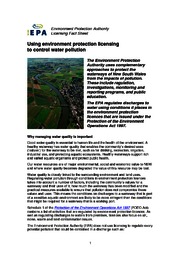The EPA issues environment protection licences to the owners or operators of various industrial premises under the Protection of the Environment Operations Act 1997 (POEO Act). Schedule 1 of the POEO Act lists a broad range of activities that are regulated by environment protection licences. These licences focus on protecting the environment (including human health) and address air, noise, waste and land contamination issues as well as regulating discharges to waters from premises. Licence conditions relate to pollution prevention and monitoring, and cleaner production through recycling and reuse and the implementation of best practice. All environment protection licences are available on the EPA's public register.
When exercising its licensing functions, the EPA is required to consider any of the matters in section 45 of the POEO Act that are relevant. Along with the considerations that apply to all types of pollution there are two considerations that are specific to water pollution
- the environmental values of water affected by the proposed activity
- practical measures that can be taken to restore or maintain those environmental values
The EPA regulates discharges to water using conditions it places on a facility's environment protection licence.These conditions can include
- restricting the amount of various pollutants that can be discharged
- requiring discharges to waters to be monitored and reported
- requiring that pollution control equipment operates properly and efficiently.
The EPA does not use licensing to regulate every potential pollutant that could be contained in a discharge or activity. This is because some pollutants are present at such low levels in a discharge that they are highly unlikely to pose a reasonable risk of harm to human health or the environment. Also some activities are conducted in such a way that discharges to the environment are avoided - such as where an intensive agricultural activity uses an engineered runoff retention basin.
The EPA also uses a number of complementary regulatory tools to protect waterways from the impacts of pollution: these include investigations, research, monitoring and reporting programs, and public education.
For more detail about how the EPA makes its regulatory decisions and focuses its efforts on managing potential non-trivial impacts of water pollution on the environment, see the fact sheet Using environment protection licensing to control water pollution (PDF 78KB).
For more general information on licensing see the EPA's Guide to Licensing.
For information about the licensing of sewage treatment plants in NSW see Licensing guidelines for sewage treatment plants.
Compliance and Enforcement
As a statutory authority the EPA has the legislative powers to investigate and take strong and appropriate regulatory action against licensees when there is a compliance breach. Any action taken by the EPA aims to ensure that environmental impacts are minimised, contained or repaired, and the sanctions applied reflects the seriousness of the incident and provide deterrence. To promote voluntary compliance among licensees, the EPA provides information through channels such as education programs, informal and formal advice and audits. For more detail see the EPA Compliance Policy and the EPA Prosecution Guidelines (PDF 66KB).
For examples of recent regulatory action taken by the EPA in relation to protection of waterways and water pollution incidents see the EPA media page.
The Protection of the Environment Operations Act 1997 (POEO Act) was amended in May 2006 to strengthen the consideration of water quality impacts when regulating activities that cause, have caused or are likely to cause water pollution.
Section 96(3A) of the POEO Act provides that
'The appropriate regulatory authority, when determining the action to be specified in a [prevention] notice relating to an activity that causes, is likely to cause or has caused water pollution, must consider:
- the environmental values of water affected by the activity, and
- the practical measures that could be taken to restore or maintain those environmental values, and
- if the appropriate regulatory authority is not the EPA-any guidelines issued by the EPA to the authority relating to the exercise of functions under this section.'
The EPA issued the guidelines Considering environmental values of water when issuing prevention notices (PDF 634KB) to 'Appropriate Regulatory Authorities' for the purposes of section 96(3A)(c) of the POEO Act.


